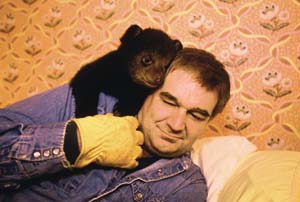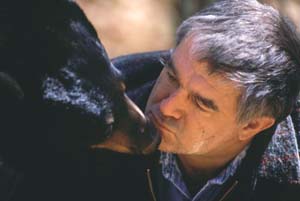 |
 |
| current issue |  |
past issues |  |
send a letter/news |  |
address update |  |
advertise |  |
about us |  |
alumni home |
Features
The Bear EssentialsPage 2 of 4
Kilham had moved away from Lyme to pursue a career as a gunsmith with Abercrombie & Fitch, Colt and other manufacturers. When he returned in 1982 to set up shop as an independent gunsmith, it seemed natural to take up animal rehabilitation as an avocation. He obtained permits from the New Hampshire Fish and Game Department and worked with fishers, skunks, porcupines, raccoons and, in 1992, his first black bear, a yearling who was sick.
 Most bear rehabilitators minimze human contact with their charges. Not Kilham. When a forester brought him Houdini and sister Yoda, the frostbitten cubs moved into Kilham's guest room. Photo by Robert Caputo |
I didn't plan to study bears," said Kilham, who majored in wildlife management at UNH. "But working with Wobbly bear got me hooked. I'd always had the idea that the way to learn about animals was to start with a young one and watch it grow up, that you would learn more that way than by just watching adults. And bears have a long, 18-month dependency. Two things I didn't realize when I began were how little was known about black bears and how much these little guys would teach me."
It surprised me, too, that so little is known about an animal with which we live in such close contact. In our culture, we grow up with bears from the time we're given Teddy bears to keep us company in the crib. Smokey the Bear warns us about fires. Yogi and other animated bears entertain us. Winnie the Pooh and his countless cousins populate our bedtime stories.
We may love them when we're children, but we have not tolerated them very well as adults. Black bears once roamed throughout North America, but European settlers viewed them as pests and hunted them mercilessly. By the early 1900s, they had disappeared from large parts of their range, and bounties were still being paid on them into the 1950s. The New Hampshire population dipped to below 500 in the 1940s, when there were only 175,000 black bears left in all of North America.
But bears are remarkably adaptable, and in the last 50 years, despite the fact that licensed hunters kill 40,000 bears annually, they have been making a comeback. There are now about 700,000 black bears in 32 states, Canada and Mexico; about 5,000 live in New Hampshire.
As the bear population increases, and as human settlement pushes farther into their habitat, encounters between bears and people become more common. The number of incidents on woodland trails and at back-yard bird feeders and garbage cans grows every year. And our ambivalent attitude persists: we like seeing the bears, but we don't particularly like it when they want to come into the house. Our fears, however, are entirely unwarranted. Since 1900, only 33 people have been killed by bears in North America, which means that a person is 4,000 times more likely to be struck by lightning. As with most wild animals, our fear is a result of ignorance.
"We know more about the lions, wildebeests, and elephants on the Serengeti Plains than we do about the bears that live in our back yards," Kilham said in astonishment. "When I got interested in bears, I read everything I could get my hands on, but there wasn't much. There were some population studies, but almost nothing on behavior. I couldn't believe it."
 Offering his scent, Ben Kilham greets Squirty, one of the 34 orphaned black bears he has returned to the wild using a radical technique: becoming their mom. Photo by Robert Caputo |
Kilham also discovered that most orphan bears, after they had been raised and released into the wild, did not fare very well. They seemed to be dying or becoming nuisances with a penchant for raiding garbage dumps and bird feeders. "The usual way to raise orphans is to minimize contact--put a tarp over their cage so they can't see people and stick food in through a hole," Kilham said. "The idea is that they will not get used to people feeding them. It's ironic, though, because bears know the world primarily through smell, and they know very well who's on the other side of the tarp. The bears are kept in cages for 18 months, then driven into the woods and released. But it doesn't seem to be working very well."
Kilham decided to try a different approach. He learned from Wobbly and subsequent cubs he's raised that bears are sensitive, intelligent and emotional creatures, and it occurred to him that they need more than food--they need security and love. They need mom.
Kilham kept Yoda, a female, and Houdini, a male, in a spare bedroom of his house, bottle-feeding them and encouraging them to play with each other and him. The cubs soon came to treat him just as they would their mother, crawling into his lap to nurse, suckling his fingers and ears in signs of affection and climbing over him in play. Persistent scars on his face and hands attested to the keenness of their little claws. But a house is not a good place to keep growing bears, and when the weather warmed and the cubs had recovered their strength, Kilham took them to a large pen he'd built in some woods he owned outside of town.
Watching him prepare the pen for the cubs' arrival was like watching a mother preparing a nursery for a newborn baby. He made sure the wire walls were strong enough to keep the cubs from wandering off and coyotes or other predators from getting at them. He dragged big logs into the pen for them to climb, layered a wooden box with warm straw to sleep on, set out pails of water and even brought toys for them to play with.
Twice a day Kilham visited the cubs with baby bottles full of formula and apple juice. This invariably sent them into a frenzy as they clawed their way into his lap and settled down to nurse. As the cubs got older and able to handle other foods, Kilham supplemented the bottles with a dry dog food that is pressed into hard and soft bits of different colors. As if to demonstrate their individuality, Yoda always picked out the hard red and brown ones. Houdini preferred the soft yellow and orange ones. Once they were sated with food and drink, Kilham took them for long walks in the woods.
Page: < Prev 1 2 3 4 Next >Easy to print version

